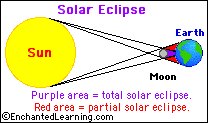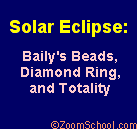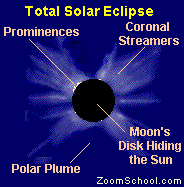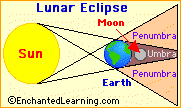|
- Eclipses occur when a large shadow travels across the
surface of the Earth.
- Umbra - The Umbra is the darker part of the shadow.
- Penumbra - The Penumbra is the lighter part of the shadow.
- Total Eclipse - Observers on the Earth's surface who are
shadowed by the darker umbra would see a total eclipse.
- Partial Eclipse - Observers on the Earth's surface who are
shadowed by the lighter penumbra would see a partial eclipse.
Solar Eclipses occur sometimes when the Moon passes between
the Sun and the Earth at New Moon. The shadow of the Moon falls on the Earth appearing to block out (eclipse) the Sun.
Solar Eclipses
  A solar eclipse happens when the moon blocks our view of
the sun. This happens when the Moon is exactly between the Sun and the Earth. A solar eclipse happens when the moon blocks our view of
the sun. This happens when the Moon is exactly between the Sun and the Earth.
The longest solar eclipses occur when
the Earth is at aphelion (farthest from the Sun, making the solar disc smaller) and the
Moon is at perigee (closest to the Earth, making the Moons apparent diameter larger).
Stages in a Total Solar Eclipse
 BAILY'S BEADS: BAILY'S BEADS:
Baily's
beads (often spelled Bailey's beads) are bead-like bursts of light that appear about 15 seconds before and after totality
during a solar eclipse. Baily's beads are caused by light shining through valleys on the edge of the moon. They were named for the British astronomer Francis
Baily (1774-1844), one of the founders of the Royal Astronomical Society.
DIAMOND RING:
The "Diamond Ring" is a large burst of light that appears
a few seconds before and after totality.
TOTALITY:
Totality is the short part of an eclipse when the moon entirely blocks
the Sun. Totality usually lasts for just a few minutes (no more than 8 minutes in any one location on Earth).
What We Can See During Totality

During a total solar eclipse some parts of the Sun that we normally can't see become visible,including
the corona (the outermost layer of the sun's atmosphere). The corona is mostly
X-ray emissions (which we can't see), but light from the photosphere is scattered by the loose electrons in the corona's plasma and
we can see this. Normally, the intensely bright light of the photosphere (the visible disk of the Sun) dominates the corona
and we don't see the corona. During an eclipse, the moon blocks the photosphere, and we can see the faint, scattered light
of the corona (this part of the corona is called the K-Corona).
In the few minutes of totality, we can see the coronal
streamers, polar plumes, and prominences.
Types of Solar Eclipses
- Partial Solar Eclipse - A partial solar eclipse is when the
Moon only covers part of the solar disc.
- Total Solar Eclipse - A total solar eclipse is when the Moon
appears to cover the entire solar disc. Total solar eclipses are only visible from a very small area on Earth, a narrow track
that moves across the Earth's surface (as the Earth rotates). The partial phase of a total eclipse lasts about an hour. In
any one place, totality (when the solar disc is entirely covered) lasts no more than 8 minutes. During totality, the sky is
dark enough to see stars in the sky.

- Annular Eclipse - During an annular eclipse, the sun looks like
an "annulus" or ring. The ring is visible when the Moon does not entirely cover the disk of the Sun during a solar eclipse.
This type of eclipse happens when the Sun is at perihelion (closest to the Earth, making the solar disc appear larger) and the Moon is at apogee (farthest from the Earth, making it look smaller).
Lunar Eclipses occur sometimes when the Moon passes on
the opposite side of the Earth from the Sun at Full Moon. The Moon passes in the Earth's shadow. It appears dull and can only
just be seen.
Types of Lunar Eclipses
 Total Eclipse - When the entire moon enters the Earth's umbra (the darkest part of its shadow), this is called
a total eclipse. Total Eclipse - When the entire moon enters the Earth's umbra (the darkest part of its shadow), this is called
a total eclipse.
Partial Eclipse - When only part of the moon enters the Earth's umbra, this is called a partial eclipse.
Duration of Lunar Eclipses
During an average total lunar eclipse, the moon is within
the Earth's umbra for about an hour. This is called totality.
Frequency of Lunar Eclipses
Since the plane of the moon's orbit is inclined about 5°:
from the plane of the Earth's orbit, lunar eclipses are relatively infrequent. Lunar eclipses occur, on average, about every
6 months. There are about two lunar eclipses each year (visible somewhere on Earth).
|

